|
G
|
|
|
Born: 1812, died 4th June 1856, (Radical)
Despite coming from a privileged background, Richard Gardner was a radical. He went to Charterhouse School, then Manchester School, then finally Wadham College, Oxford University. He was a barrister and member of the Inner Temple. In 1842, he was a member of the Manchester Complete Suffrage Union and that year published An address to the middle and working classes engaged in trade and manufactures throughout the empire on the necessity of union at the present crisis.
In 1847, he was elected as a Radical member of parliament for Leicester alongside Sir Joshua Walmsley. However, as a result of a petition he was unseated the following year. Although the election was described as the 'most sober and least lavish in memory,' the Tories alleged corruption and proved their case to their colleagues in Parliament. The petition was something of a double edged sword since it served to awaken public feeling against the corrupt practices which had been endemic at election times - usually benefiting the Tories.
Despite being branded as Chartists, Gardner and Walmsley were re-elected in 1852, and retained their seats, notwithstanding a second petition by the Whigs and Tories. Gardner was a supporter of national (secular) education and, as a supporter of free trade, he took an active part in the repeal of the Corn Laws. Although a member of the Church of England, he was liberal in his views on religion and civil freedom. He supported the separation of Church and State and opposed to public endowments being used for religious purposes. Gardner was regarded as a 'learned theoriser' and a popular orator.
During his election campaigns, Gardner had considerable support from the framework knitters. Despite that support, Gardner ignored working class opposition to frame charges. These charges were a major working class grievance, since knitters had to pay the rent of their frames even though they had no work. 13,000 workers and 900 ratepayers signed a petition in support of Henry Halford's bill to abolish frame charges, yet Gardner voted against it. (Walmsley voted in favour)
In 1850, he married Lucy, the only daughter of count de Mandelsloh, minister plenipotentiary from Wurtemberg. He died on 4th June 1856 from a heart condition, leaving a wife and two daughters. He is buried in Kensal Green Cemetery.
Sources: Leicestershire Mercury, 14th May 1853, 7th June 1856, Blackwood's Edinburgh Magazine, Volume 52, Victoria County History.
|
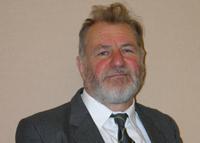 |
Died: April 2016, aged 69 (Communist Party, Labour Party, Left Unity)
Geoff Gay worked as a maths teacher at Burleigh Community College from 1976 to 2000. He was active in the NUT and was assistant secretary of Leicester and District Trades Union Council from 2013 to 2016.. Although he had motor-neurone disease, he died of a heart attack.
In 1966, as a student, he joined the Communist Party of Great Britain because thought that it had a realistic programme for achieving Socialism in Britain. Having no truck with apologists for the Soviet Union, he eventually came to the view that the internal divisions within the party were irreconcilable. However, he stayed in the CP until it wound itself up in 1991.
In 1993, he joined the Labour Party, and was a Labour councillor from 1999 to 2011 for the Shelthorpe ward in Loughborough, where he campaigned on behalf of residents on the estate. In 2003, he was close to leaving the Labour Party over the invasion of Iraq and over Labour's education policy, but decided to stay in because the resignation of a councillor would have been embarrassing.
He then decided to leave following privately-educated Tristram Hunt's appointment as education spokesperson and his continuation with the Tories' quasi-privatisation of publicly-funded education . He resigned in late 2013, and became a founding member of Left Unity. Geoff was also a long standing member of the Leicester Secular Society and an active member of the Leicester group of Unlock Democracy and a member of the Electoral Reform Society.
Geoff was also an avid fan of rugby and coached the Under 15s at Burleigh as well as the Under 19s Loughborough Colts. He was also involved in the North Leicestershire and County Under 15s. His close friend and teacher, Lea Toone told the Loughborough Echo: "He was a very good councillor and well rated. He was a single bloke and put his time in. He was also a union representative for the National Union of Teachers. He was a hard working, honest guy and a character."
Sources: Geoff Gay, Loughborough Echo & author’s personal knowledge
|
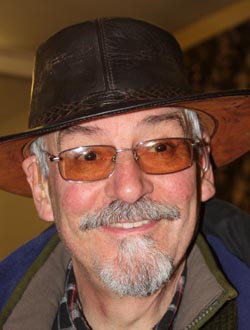 |
Died: March 22nd 2020, aged 73 (Secularist)
Michael Gerard was a stalwart and long standing member of the Leicester Secular Society. He was instantly recognizably by his hats and his distinctive rich plummy voice. Michael was president of the Society in 2011. During the 1970s he was an active member of the Leicester group of the Anarchist Workers Association and was later involved in a host of causes and pressure groups. These included C.N.D., the Palestine Solidarity Campaign and the Friends of Bethlehem. He helped arrange the visits of children from Bethlehem to Leicester and the shipment of surplus musical instruments to Cuba. He took a great interest in the politics of South America, visiting Guatemala and Nicaragua, learning Spanish in the process.
Before retiring, Michael was a peripatetic teacher who taught partially sighted children. This irony was not lost on him when he too lost his sight. He had a great love of music and his violin playing was the foundation of the Greenshoots Ceilidh band.
Having been ill with what he thought was pneumonia, tests revealed that he had Covid 19 and the quarantine regulations at the Royal Infirmary meant that his family were unable to see him. He died on Sunday March 22nd 2020.
Sources: author’s personal knowledge
|
 |
Died: May 22nd 2005, aged 56 (Labour Party)
Gordon Getliffe was elected to represent Beaumont Leys on what was then the county council in 1993, before taking a seat on the new city council in 1997. He was described as a key player in the team which helped bring £13 million of European regeneration cash to Beaumont Leys to combat problems such as crime, unemployment and poor quality housing. He was remembered for being the local councillor who was truly local.
Sources: author’s personal knowledge
|
|
Died: January 1994 aged 76
After training in Liverpool as a plumber, in 1949, Harold Gibson joined the hosiery union. He later became district secretary of the northern region and in 1962 he was elected General Secretary, holding the post until 1975. He then became general president until he retired in 1982.
Sources: Leicester Mercury, 13th Jan 1994
|
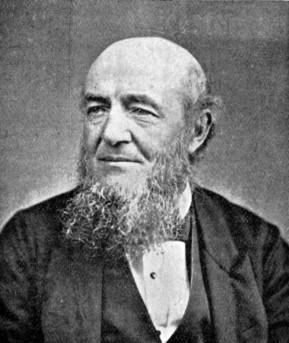 |
Born Leicestershire 1818, died: 1883 (Owenite, Liberal & Secularist)
His father had been a carpenter and a Quaker. Josiah and Benjamin Gimson started an engineering business in 1842 on Welford Road, Leicester, after serving their apprenticeship at Cort's foundry. In the early years the principal product of the firm was braid machinery for the elastic web trade; Gimsons also advertised as brassfounders, millwrights and manufacturers of boot and shoe making machinery.
In the 1840s Josiah was active in support of Robert Owen's socialist ideas. He was president of the local Owenite branch, the Rational Society, from 1844 onwards. He was a supporter of the rationalism of G.J. Holyoake and in the 1870s Gimson became the influential leader of the Leicester secularists.
Though unorthodox and therefore unpopular with churchmen like Canon Vaughan, Gimson stood consistently for the utmost freedom of discussion and this cause was one to which he gave his heart. The Leicester Secular Society, formed in 1852, faded out of existence, was revived in 1861 and was revived again in August 1867 with Gimson as treasurer. It has been in continuous existence ever since.
In February 1847, Gimson works on Brown Street had suffered a disastrous fire and he was under-insured. Both he and his brother went bankrupt, for 25 years later, he scrupulously paid off his creditors. The Leicester Journal commented:
Mr. Gimson has set a noble example, and one which, in these day of commercial morality will, we fear, not be largely imitated.
In October 1872 he paid off his last debt and the following month began to collect money for a Secular Hall. The Leicester Secular Hall Company was formally constituted on the 2nd May, 1873 and Gimson was a major shareholder. A plot of land of some two thousand square yards was purchased for £4,500 and the hall was opened in 1881.
Baradlaugh and Holyoake offered two different approaches as to how Secularism could best be advanced. This hinged on whether the Secularists should directly attack the churches. Holyoake and Gimson’s view was that they should not do so, but rather work for the diffusion of Secularist principles, even attracting liberal-minded churchmen to the ranks of Secularism. Bradlaugh and his supporters, however, took a widely different view. Maintaining that the churches stood in the way of Secularism, they held to be the task of the Secularists to do everything possible to weaken their hold on the people.
In 1877 Charles Bradlaugh and Annie Besant decided to publish The Fruits of Philosophy, Charles Knowlton's book advocating birth control. Besant and Bradlaugh were charged with publishing material that was “likely to deprave or corrupt those whose minds are open to immoral influences.” In court they argued that “we think it more moral to prevent conception of children than, after they are born, to murder them by want of food, air and clothing.” Besant and Bradlaugh were both found guilty of publishing an ‘obscene libel’ and sentenced to six months in prison. At the Court of Appeal the sentence was quashed.
In 1877, Gimson and his allies in the National Secular Society, believed that Bradlaugh’s leadership was too controversial and attempted to get him to stand down. When that failed they backed the formation of Holyoake’s short lived rival British Secular Union and the Leicester Secular Society parted from the National Secular Society. Yet, such was Bradlaugh’s standing among rank and file secularists that both he and Annie Besant were present to open the new Secular Hall in 1881 and his portrait hung next to that Gimson, Wright and Holyoake in the hall.
In 1872, Josiah joined the first local committee established to promote women's suffrage and was also active in the Workmen's Peace Association. In 1879 he gave an address entitled "War and how to avoid it." He described the situations of nations standing in an attitude of armed defence each towards the other, as one of the most barbarous features of the age.
Gimson's business grew and expanded and in 1878 the Vulcan Works was opened on Humberstone Road/Nedham Street adjacent to the Midland Railway. He became one of the largest employers in the city, employing 270 men & 1 boy in 1881. He prided himself on the favourable wages and conditions he offered his workers.
Around 1872, Messrs. Gimson & Co. had introduced a system of industrial partnership to their engine works which, it was claimed added a bonus of 11% to wages. The scheme ended in 1879 not because of a 'diminution of profits,' but through staff disinterest. (K.S. Gimson). Gimson & Co was also one of a number of local firms that met the demands of the Nine Hours Movement by reducing the working week to 54 hours.
According to G.J. Holyoake, a share of the profits (after a dividend on the capital had been paid) was initially entrusted to ‘leading workmen.’ Those selected could then nominate others whom they discerned to be “capable and willing to increase the prosperity of the company by zeal and judgment in the discharge of their duties. This plan had the advantage of limiting the division of profits to those who showed increased efforts in augmenting them, and left the responsibility of excluding the indifferent to their fellow-workmen.”
In January 1857, Josiah Gimson's wife Elizabeth died. They had married in 1843 and had five daughters and two sons. In 1858 he married Sarah Ansell at St Mary de Castro Church and had another five children.
In 1877, he was elected to the town council as a Liberal for West St Mary’s ward. He soon became vice-chairman of the Floods, Highways and Sewerage Committee. Shortly before his death, he was active in support of G.J. Holyoake's attempt to be selected as a Liberal candidate for Leicester. On his death, in addition to his firm, he had a personal fortune of £20,000.
Sources: Leicester Mercury 13th Febrary 1847, Leicester Journal, 4 October 1872, Midlands Free Press, 10th January 1874, Leicester Chronicle 4th Ocober 1879, F. J. Gould, The History Of The Leicester Secular Society, 1900, George Jacob Holyoake, The History of Co-operation, 1875, David Nash, Secularism, Art and Freedom, Elizabeth Crawford, The Women's Suffrage Movement in Britain and Ireland: A Regional Survey
|
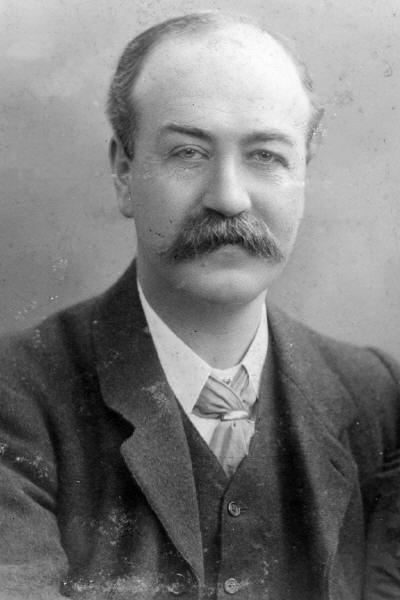 |
Born 1860, died 1938 (Secularist & Liberal)
Sydney Gimson was a son of Josiah Gimson and worked in the family engineering firm, Gimson and Co. Sydney, like his mother, was an active Unitarian for many years. Following death of his father, Sydney began to play a very active part in the Secular Society, becoming its secretary, treasurer and later president. He was President of the Secular Society from 1883 until shortly before his death.
Sydney's older brother J. Mentor Gimson (died 1925) was active from the 1880s in support of the Secular Hall Company and in 1908 was President of the Leicester & Leicestershire Women's Suffrage Society. His younger brother Ernest (1864-1919) became an innovative Arts and Craft furniture designer. William Morris’s visits to Leicester had a profound influence on both Ernest and Sydney. However, in Sydney’s case this influence only extended to matters of art. Sydney vigorously opposed Socialism and supported the Personal Rights Association and ‘individualism.’ A Leicester branch of the Kyrle Society was set up in 1880 to improve the urban environment including the planting of public gardens and trees and Sydney was president from 1913 to 1915.
Although Gimson was firmly wedded to the principle of the free discussion of ideas, as an employer he was less amenable to the freedom of his workforce to belong to a union. Whilst his father had backed the nine hours movement, his resisted the campaign for eight hours. When the engineering union (A.S.E.) began a strike in London for a 48 hour week in the summer of 1897, the Employers' Federation declared a national lockout. One of the factories in Leicester which locked out union members was Messrs Gimsons. In a letter to its workers, the firm acknowledged that whilst none of its workers had gone on strike, union members were nevertheless contributing to union funds and therefore supporting the strike. The letter said that a 48 hours week would add to Gimson’s costs and put the firm at a competitive disadvantage. It supported the lock-out and refused to allow any union member into work. This was about 25% of the workforce.
In November 1897, Sydney was forced to defend his action to Eleanor Marx who was speaking at the Secular Hall. Justice recorded that after her lecture:
There was an immensely lively and long discussion, and Mr. Gimson tried to put the case of the Federation. But although Gimson is immensely popular (even with his own locked-out men, for he is honest, and, as his hard work for Secularism shows, no ordinary middles class man) the audience was with the workers, and nothing was more applauded than the contrast between the employers' international, backed by the German Emperor and German police, and the international of the workers. I should, in justice to Gimson, say that he took it all in the kindliest and best humoured way
Sydney Gimson was elected to the Town Council in 1910 and served as Chair of the Museum and Art Gallery Committee and was responsible for acquiring the buildings that are now Newarke Houses Museum. He also served as a member of the Municipal Technical and Art Schools Committee and the Colleges of Art and Technology Committee until his death.
The First World War was opposed by many Secularists, however Sydney declared that it was a "just war forced upon (England) by the military aggression of Germany" and urged young men to enlist. He was then appointed chair of Leicester Town Council's Belgian Refugee Committee, and the Secular Society raised a subscription in January 1915 to guarantee a house to a Belgian family. They remained as guests of the Society until February 1919. Gimson Engineering was heavily involved in the manufacture of munitions for the was and in 1915 Gimson & Co co-founded the Leicester District Armaments Group of Engineering Employers. Sydney was chairman of the Board of Management of the local Munitions Committee. This was all a far cry from his father's espousal of international arbitration
Gimson said later that he saw his role during the war as trying to hold the Secular Society together and guiding it on a path of neutrality. However, Gimson's main influence seems to have been to prevent the Secular Society from opposing the war. The opposing views in the Secular Society can be seen in 1917, when it rejected a call for a negotiated peace and but then deplored the disenfranchisement of conscientious objectors. The Secular Hall was used on numerous occasions by the Union of Democratic Control when other venues were refused to them. During the 1918, election when the Labour Party found it very difficult to obtain premises, because its opposition to the war, Gimson firmly supported the use of the Secular Hall for the Labour election campaign.
In the 1920s, Gimson became President of the Leicester and County Saturday Hospital Society
Sources: Leicester Chronicle 17 July 1897, Leicester Journal 1 October 1897, Justice. 20 November 1897, --> Midlands Free Press, 17th Oct 1914, F. J. Gould, The History Of The Leicester Secular Society, 1900, S. Gimson, Random Recollections of the Leicester Secular Society 1932, Edward Royle, The Records of the Leicester Secular Society, 1981, David Nash, Secularism, Art and Freedom,
|
|
Born Leicester 1840, died: 1930 (Liberal & Suffragist)
Mary Gittins grew up in a comfortable Georgian house in Churchgate. She left home in 1865 to become the governess to the family of George Melly MP which gained an entrée to Liberal circles in London and Liverpool. In 1879, she settled in Birmingham as Art Mistress in the Edgbaston High School. She returned to Leicester in 1900 and her Liberalism became ardent Socialism and Pacifism. For many years she worked for Women’s Suffrage, though never on militant lines She was secretary of the local branch of the National Union of Women Workers (later National Council of Women) from 1900 to 1916 and in that capacity she helped initiate the Bond Street Maternity Hospital and the movement for Infant Welfare. In 1913, she resigned as president of Leicester Women's Liberal Association in protest at the Liberal Government's refusal to grant votes for women. That year, large numbers of the officers and committee of the Women's Liberal Association had also resigned for the same reason. A motion to disband the W.L.A. was only lost by one vote.
Catherine, was also the Secretary of the local Kyrle Society; founded by Miranda Hill (sister of Octavia) and supported by William Morris. The Society provided art, books and open spaces to the working class poor, around the slogan ‘Bring Beauty Home to the Poor.’ This involved, at first, artistic decoration of hospitals, schools and working-class clubs. The Leicester branch, founded in 1880, lasted nearly fifty years before being merged with the Leicester Civic Society.
In 1917, Sylvia Pankhurst's Workers' Suffrage Federation was meeting in her studio a 2 Berridge Street and she was active in the anti war Union of Democratic Control.
Sources: Leicester Daily Post, 28 February 1913, Isabel Ellis, Records Of Nineteenth Century Leicester, Common Cause, 11th April 1913, Woman's Dreadnought, 2nd June 1917
|
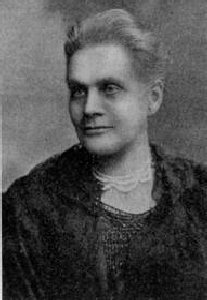

|
Born Leicester 1845, died: 7th August 1910 (Leicester Women’s Liberal Association)
Edith Gittins, like her elder sister, was a watercolour artist and a teacher of drawing, but the whole of her life was spent in Leicester and centred round the Unitarian Great Meeting Chapel. She was an unusual combination of artist and social reformer, she was a born leader gifted with much personal charm. High minded like her older sister Mary, every man to whom the Gittinses were closely related were inadequate to the claims made upon them. She founded the Leicester Women’s Liberal Association in 1886 at a time when women had no political power and led it for many years; she was the secretary of the Leicester Women’s Suffrage Society, through times of much discouragement. In 1890, she gave a lecture of women's suffrage to the Leicester Liberal Club and was probably the first local woman to fulfil such a public function on the question of the vote. She told the meeting that:
The granting of the franchise had not been based in the past on education or wisdom, but it had been conferred as a matter of justice. Wisdom was not a qualification, but the payment of a rate or the possession of land to a certain amount. At the present time about 800,000 women in the United Kingdom had those qualifications, and their contention was that they ought to be able to vote at parliamentary elections if they wished to do so.
In 1907, she spoke at a meeting of the Women’s Labour League and distanced herself from the tactics of the WSPU. She was active in the Leicester Branch of the National Union of Women Workers up to her death and was a vice president of the National Union Women's Suffrage Societies.
She was also a watercolour artist and drawing teacher. As a member of the Leicester Society of Artists, she exhibited several landscape paintings at the Royal Academy and the New Walk Museum and Art Gallery holds several of her watercolours. She was a disciple of Ruskin and Morris and according to Sydney Gimson, she almost worshipped the latter. The painting of Bablake School (left) was probably undertaken because the school was founded in 1344 by Queen Isabella of France.
Edith taught at the Great Meeting Sunday School for 40 years. In 1907, she attempted to bring a court case in which she argued that women had been unlawfully deprived of the vote.
When she died, Edith Gittins left a bequest of £500 to erect a sculpture of Ethelfloeda (d. 918), the eldest daughter of Alfred the Great. As Queen of Mercia, she re-captured Derby and Leicester from the Danes in 918 A.D. The work was commissioned by the Corporation in accordance with her wishes and Benjamin Fletcher and a Leicester Art School colleague, Crosland McClure, designed a public drinking fountain surmounted by Fletcher’s bronze sculpture. In 1922 was finally positioned in Victoria Park (rather than the High Street as she had wanted)
After the statuette was stolen in 1978, the fountain was relocated to the new Dolphin Square development near the Market Place and the statuette was replaced by a replica. After further acts of vandalism, the statuette and upper part of the fountain were eventually installed in the entrance hall of the City Rooms in Hotel Street, but following the sale of the City Rooms it is now in the courtyard of the Guildhall.
Sources: Leicester Chronicle, 19th April 1890, Isabel Ellis, Records Of Nineteenth Century Leicester, David Nash, Secularism, Art and Freedom, Howes, C. (ed), Leicester: Its Civic, Industrial, Institutional and Social Life, Leicester 1927, Elizabeth Crawford, The Women's Suffrage Movement in Britain and Ireland: A Regional Survey
|
 |
Born: Leicester 12th November 1893 (Labour Party), died March 1978
May Goodwin was the only girl in a family of six children. She attended the Avenue Road Elementary School which she left at the age of 13 in order to enter the boot and shoe industry where she worked for 52 hours a week for a wage of 4/ 6d.
She became a skilled operator in the boot and shoe trade, before rising through the ranks of her union, NUBSO, to become a full-time official and executive member from 1939-58.
On the retirement of Mrs Bell-Richards, in 1939, she was elected President of the Leicester Women's Branch of the Boot and Shoe Union (the only women's branch of the Union in the country to be served entirely by women officers) and became responsible for the working conditions in the industry of over 6,000 women workers in Leicester & Leicestershire.
She was an expert motorist and motorcyclist. In 1942, she was awarded the MBE for services to the footwear industry, and was made a JP the following year. In 1944/45 she was elected Chairman of the City Labour Party. She became a member the City Council in 1944 and in the 1950s served as chair of the Housing Committee for many years. In 1953, she successfully opposed plans by the Tory group to sell off council houses. She was conscious of the stigma attached to living in the slums. This led her to ensure that when slum clearance re-started, former slum dwellers were not re-housed on one or two estates as they been during the 1930s. She was appointed as an Alderman in 1955 and became Lord Mayor in 1961 in which office she was accompanied, as Lady Mayoress, by her very close friend, Mrs Ada Rawlings, who for many years had worked with her in the boot and shoe industry. She was chair of the Heath committee from 1962. She was commemorated by Goodwin House, on St Matthews estate which has now been demolished.
Sources: Leicester City Council, Roll of Lord Mayors 1928-2000, Alan Fox, A History of the National Union of Boot and Shoe Workers, 1958
|
 |
Born: Aston, c1856, died: 1941 (Socialist League, Anarchist Communist Group, I.L.P.& Labour Party)
Archibald Gorrie came from a Presbyterian background. In the 1870's, he was treasurer of the St Stephen's Young Men's Mutual Improvement Society and a member of the Rev Meyer's Total Abstinence Society. However, he was ‘converted’ to socialism after listening to Tom Barclay speaking from the back of a dray in Humberstone Gate. He became one of the founder members of the Socialist League in Leicester.
Gorrie was in business on his own account as a draper and Barclay described him as ‘a middle class activist who would always put his hand in his pocket to pay a speaker’s expenses or for the rent of a hall.’ He became secretary of the Leicester Branch of the Socialist League in 1889 and, during the 1890s, was active as both a Christian Socialist and a member of the Anarchist Communist Group. He was also active in the local branch of the Land Nationalisation Society. In 1898, the remaining Socialist Leaguers regrouped as the short lived Leicester Socialist Society. This claimed support from dissident I.L.P. members and linked itself to the old anti-vaccination campaign.
During the Boer War, Gorrie was active in the Leicester Society for the Promotion of Peace and was secretary of the Anti-Conscription League. From 1902, he was involved with the Leicester Passive Resisters' League and the Leicestershire, Leicester and Rutland Citizens' League which spearheaded non-conformist opposition to the 1902 Education Act. He was among those who refused to pay the share of rates that supported sectarian religious education in schools. As a result, his household goods were seized and sold to pay his debts to the Council.
He was elected to the Board of Guardians c1910 as an I.L.P. candidate and was treasurer of the City of Leicester Labour Party from 1923 to 30. He was the Labour candidate for Wycliffe in 1928 and was was Pethwick-Lawrence's agent in Leicester west during the 1929 general election. He was eventually elected to the City Council for Latimer ward in 1934.
Archibald Gorrie’s grandson was active in the anti-fascist movement. He and others hung and anti fascist flag/banner on the building between High Street and Silver Street after gaining access from the Silver Arcade c1935
Sources: Leicester Chronicle, 28th November 1896, 26th May 1900, Archibald Gorrie Collection of Political memorabilia, University of Leicester Library, election address 1933, census returns
|
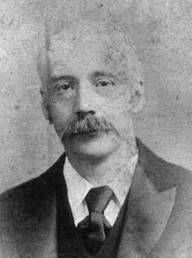
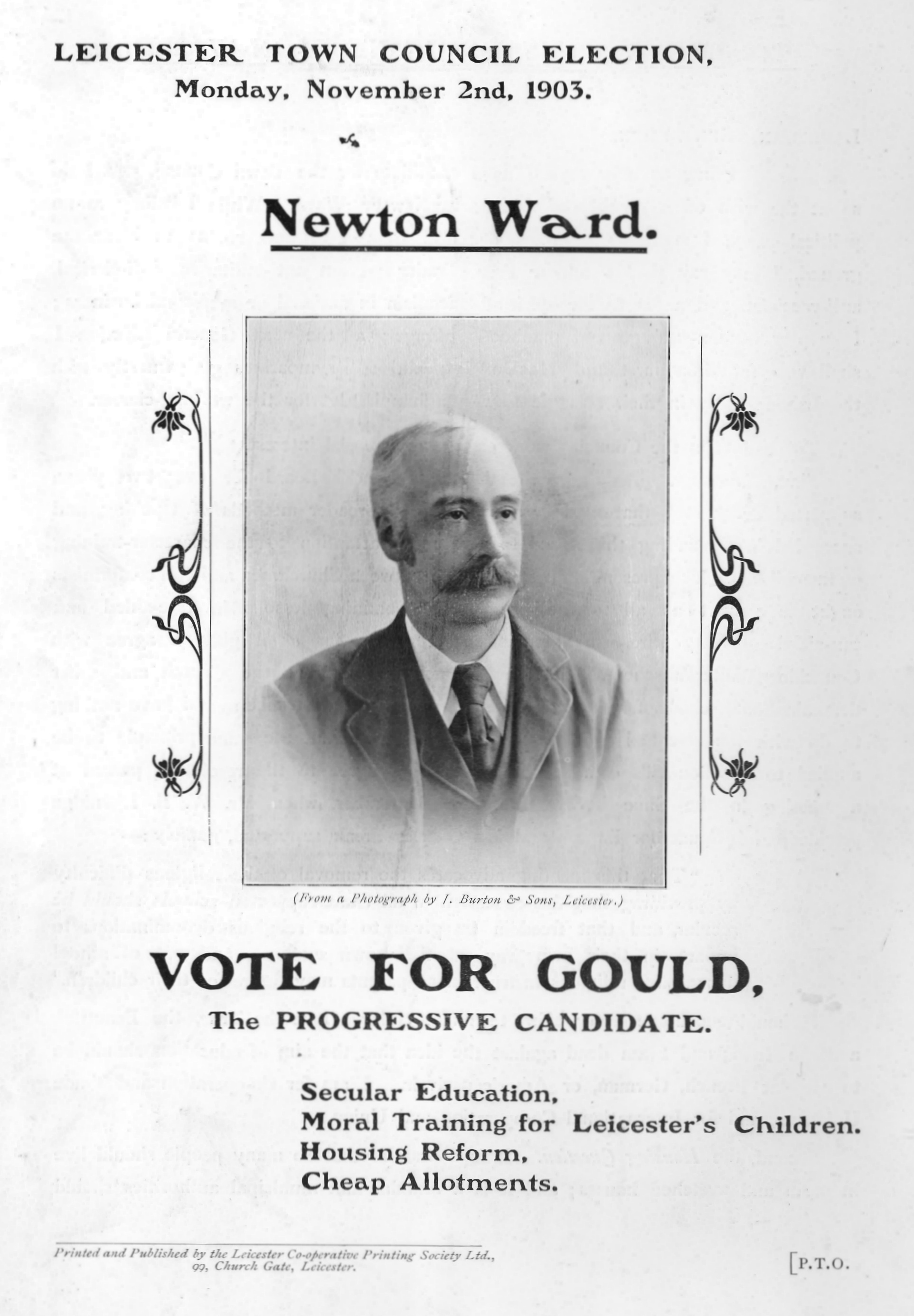
Gould's 1903 election addresss
|
Born: Brighton, December 19th 1855 died: 1938 (Secularist, I.L.P., British Socialist Party, National Socialist Party, Social Democratic Party, Labour Party)
Frederick Gould attended choir school at St. George's Chapel, Windsor for three years and Chenies school for nine years. He then studied theology and in 1877 became a teacher at the Church school in Great Missenden. It was here where he began to develop doubts about his own religious faith. In 1879 he moved to London, married, and began working as a teacher at the Turin Street Board School in Bethnal Green.
By the early 1880s he had become actively involved in the Secularist movement and was also a rigid abstainer. At the end of 1887 some of his columns in the Secular Review came to the notice of his employers, the London School Board, and he was he was exempted from teaching the Bible.. He was transferred to Northey Street, Limehouse and taught there for eight years. He later asked to be allowed to resume Bible teaching, to stress its ethical rather than supernatural elements, but this was refused. His desire to continue teaching principles of morality and religion was raised in the House of Commons in 1888, and in the National Reformer 1891, but to no avail.
Gould left teaching in 1896 and in April 1899 he was appointed as full-time organiser for the Secular Society where he succeeded Joseph McCabe. He was already known in Leicester since he had first spoken at the Secular Hall in 1883.
His role was more of a pastor to the society and in 1900 he published The History of the Leicester Secular Society. During this period he became increasingly influenced by the writings of Auguste Comte and in 1902 he joined the Positivist Church of Humanity. Gould argued that Comte's positivist philosophy was essentially socialist.
Although it has been said that his arrival breathed new life into the Secular Society, he was also a divisive figure. His puritanical attitudes on the issue of drink and his criticism of the more working class Secular Club seemed to suggest he preferred the Secular Society to be better fewer and purer.
In 1900, he stood as the Secular Society’s candidate for the school board and was elected. In 1901, he persuaded the School Board to adopt a programme of Ethical and Moral Instruction in Schools. Gould was a lifelong champion of moral education and wanted children to have an inclusive ethical instruction, free from religious bias. He was a leading light in the Moral Instruction League, founded in 1897 which sought to encourage the teaching of secular moral education in schools. In the course of his life, Gould produced nearly 50 books on subjects relating to moral education, as well as hundreds of articles, pamphlets, and teaching materials.
In 1901 he joined with Burt Williams (well known in the Co-operative world), F. W. Rogers, and others in re-launching Tom Barclay’s Leicester Pioneer. He was an unpaid regular columnist until 1909 when he resigned after the editor. Arthur Reynolds declined to published some of material. He joined the I.L.P. in 1904 and acted as secretary to the Labour group on the Town Council.
Following the dissolution of the School Boards, he stood for the Town Council in 1903 for Newton ward for the I.L.P. and lost. In 1904 he stood against a Conservative publican in Castle ward and was elected on a teetotal platform by Wesleyans and Baptists. (Gould had ended the sale of alcohol in the Secular Hall in 1902) His Secularism was obviously seen as the lesser evil. He lost the seat in 1907 and was re-elected for Wyggeston ward in 1908.
On April 30th 1908 Gould resigned as Secretary of the Secular Society, though he continued to be a member, and with two others set up the Leicester Positivist Society, which lasted two years. They set up a ‘Church of Humanity’ at 14 Highcross Street.
Sometime in 1908, he appeared in court as a passive resister having refused to pay the share of rates that supported sectarian religious education in schools. (see Archibald Gorrie above) Although a member of the I.L.P. he was very sympathetic to Henry Hyndman's Social Democratic Federation.
In 1909, he was one of the first to adopt the term "Humanist" in its modern sense and that year published "On the Threshold of Sex" which was a pioneering sex education book intended for 14 to 21 year olds.
In 1910 he resigned from Leicester Town Council and moved to Ealing to become ‘Demonstrator’ of the Moral Education League (which was dissolved in 1919). In this capacity, he travelled across the UK, as well as to the US, and India, lecturing on and promoting the cause of non-theological moral education. Although, his subsequent political life after he left Leicester lies outside the remit of this page, his experience in the town continue to feature in his writings.
Following he departure from Leicester his politics were very much those of the various manifestations of Henry Hyndman's parties : the Social Democratic Party, the British Socialist Party and the National Socialist Party. He was a major contributor to its paper Justice well into the 1920s. Not surprisingly he gave his backing to British Socialist Party candidate Edward Hartley during the 1913, Leicester bye-election.
Although he claimed also to have left the I.L.P. in 1916, by 1914, he was chairman of the Ealing Branch of the B.S.P. His continued interest in Leicester politics was driven by the divide in attitudes towards the First World War and a dislike of Ramsay MacDonald. Initially ambivalent about the war, he came to the view that it was the moral duty of British citizens to support the cause of the Allies. No doubt spurred by the I.L.P.'s anti-war stance, Gould starts to voice a critique of the I.L.P. in Leicester. However such criticism is singularly absent from his pre 1914 pronouncements.
In 1916, following the split in the B.S.P., over the war Gould became a luminary in the unfortunately named National Socialist Party which was the pro-war faction of the B.S.P. According to the veteran socialist E. Belfort Bax:
His attempt to reconcile his sentiments of national patriotism with Socialist Internationalism, when applied by him to the German question, appears to have got him into a tangle.
In 1917, he produced a leaflet entitled "A Letter to Leicester" in which he agued for the prosecution of the war until the "bad spirit" (Germany) was "checked, broken and damned." In 1923, Gould wrote The Life-Story of A Humanist which gave an account of his years in Leicester.
Sources: Justice 26th May 1906, 20th February 1909, 6th August 1914, 19th October 1916, 20th September 1917, 21st February 1918, David Nash, Secularism, Art and Freedom, F. J. Gould, The History Of The Leicester Secular Society, 1900, The Life-Story of a Humanist, 1923
|
 |
Born: April 3rd 1941, Croydon, died: December 22nd 1982 (Communist Party)
Maggie studied sociology at Leeds University, where she active in the Communist Party during the 1963 elections. She came to Leicester to train as a teacher in 1964 at the Leicester University School of Education. She was active in the Leicester University Anti-Racialist Committee, which organised a demonstration against the colour bar at the Admiral Nelson pub. In her post-graduate year, she married lecturer Dipak Nandy (later founder and Director of the Runnymede Trust 1968-73), but they separated in 1969. Both were active in the Campaign for Racial Equality. In October 1965, the Campaign illegally reproduced 3000 cyclostyled copies of the Electoral Registration form and registered some 2,000 Asian and Caribbean residents of Highfields. They then counted them at every polling station in the constituency. Just one extraordinary statistic: 94% of the Asian women eligible to vote had actually turned out on polling day.
By 1967, Maggie she was Secretary of the Leicester Campaign for Racial Equality and campaigning for stronger legislation to outlaw racial discrimination. In 1969, following the daubing of the Synagogue with slogans, she helped found the Inter-Racial Solidarity Campaign and was active in the campaigns against the National Front in the 1970s.
She taught at Bushloe and later at Countesthorpe College. She became warden of the Blaby Teachers centre and contributed many articles to Forum – a left leaning education magazine in which Brian Simon was involved. She was active in the early stages of the Youth Foundation, now a well-established organisation providing housing for black people. In 1977, she was appointed deputy head at West Moors Middle School in Dorset. She returned to Leicester in 1980 and was studying to become a solicitor when she died of cancer.
Sources: Maggie Gracie memorial booklet, author’s personal knowledge
|
|
(Communist Party)
Arthur Gratrix was a member of AEUW district committee and the Communist candidate for the City Council in Humberstone 1967. He was active in Thurnby Lodge tenants’ Association. Not to be confused with A.A. Gratrix who was a Labour councillor.
|
|
Born: Mitcham 1851 (Liberal)
George Green did not go to school and joined the London and Brighton Railway at the age of 10 as a signal box clerk. He moved around the country working as a porter and a signalman before coming to Leicester in 1878. He was active in the Amalgamated Society of Railway Servants and became secretary of the Trades Council in the 1890s. He was an ardent Liberal.
Sources: The Wyvern January 1898
|
|
Born: circa 1795, Hallaton, Leics, died 1858? (Chartist leader)
Henry Green was a grocer and tea dealer who had a shop in Rutland Street, though he later became a yarn commission agent. He was a moral force Chartist and in 1842 sided with the All-Saints Chartists. He used the term ‘mushroom Chartists’ to describe those who flocked to support the Charter during the periods of depressed trade. In 1848, he played a leading role in the movement, chairing large meetings at the Amphitheatre and other places. He was also active with the Biggsite radicals. (not to be confused with Henry Green, also of Rutland Street, who was a paper merchant and general agent.
Sources: A. Temple Patterson, Radical Leicester, Leicestershire Mercury, 25 March, 6th May 1848
|
|
(I.L.P. and Labour Party)
James Green was president of the Trades Council in 1938 and a delegate from the Transport And General Workers. He worked as the manager of the Leicester Transport Dept canteen and following his retirement, in 1953, he was elected to City Council for Newton Ward, he was a council tenant.
|
.jpg) |
Born: Leicester, Jan 19th 1873/5, died: December 1952 (I.L.P.& Labour Party)
Ernest Grimsley was born in Syston Street Leicester and one of nine children. Whilst at Syston Street Board School, he obtained part-time employment at the age of 11 and after leaving school he worked at a tackers boot shop. In 1889, was apprenticed to Mr J. M. Hemmings printers. He became a Methodist lay preacher in the 1890s and was a strong advocate of temperance. He joined the Typographical Association in 1894 and became president of the branch in 1914. He was either president or secretary for many years. He was elected to the City Council in 1919 for Castle ward. He became president of the I.L.P. in 1922 and president of the Trades Council in 1925. We applied to book the Corn Exchange for a meeting of the T.A. during the General Strike he was told "the printers of Leicester are dangerous men and could not meet in a public hall" that the hall could be booked only on condition that the officials persuaded the Leicester printers to go back to work. He became Lord Mayor in 1934 and in 1945 he stepped down from the Council.
Sources: Leicester Mercury, 7th May 1926, Leicester City Council, Roll of Lord Mayors 1928-2000, Howes, C. (ed), Leicester: Its Civic, Industrial, Institutional and Social Life, Leicester 1927
|
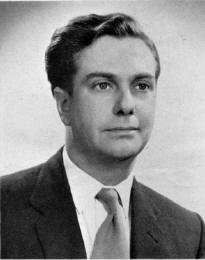 |
Born: Heanor, Nov 1926, died: October 1994 aged 67 (Labour Party)
In 1960 Colin Grundy, then a science teacher at Roundhill School, first stood for the council for Westcotes ward and lost. He was the Labour candidate in the Parliamentary elections for the old constituency of South East Leicester held in 1966 and 1970. In the General Election of 1970, he was defeated by Tom Boardman (Conservative) by just 106 votes.
Colin was subsequently elected to the Council in 1973 for the North Braunstone Ward and became a Councillor for Westcotes Ward from 1983 onwards. He became chair of the Planning Committee and was a very active supporter of Leicester’s twinning arrangements. For many years he was a teacher and deputy head at Alderman Newton’s school, eventually retiring in 1987.
He was renown for his practical jokes which were not always in good taste. He once painted a cross on the pavement outside a local chip shop and told the owner that the Council was planning to install a public toilet there. The worried owner was consequently very grateful to Colin, as his local councillor, for getting the proposal halted. At a time when there were still left and right divisions within the Labour group, he managed to keep a foot in both camps. He became Lord Mayor 1991 and is commemorated by Colin Grundy Drive, off Keyham Lane.
Sources: Leicester City Council, Roll of Lord Mayors 1928-2000, author’s personal knowledge
|
|
|
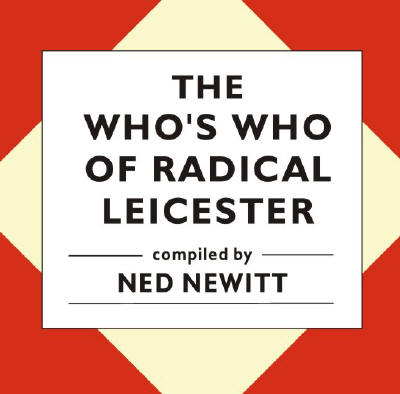 |
Back to Top |
|
© Ned Newitt Last revised: September 14, 2024.
|
|
|
Bl-Bz
Leicester's
Radical History
These are pages of articles on different topics.
Contact
|
